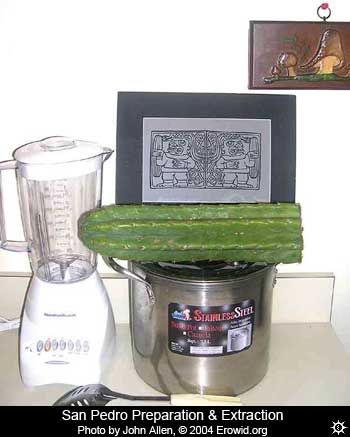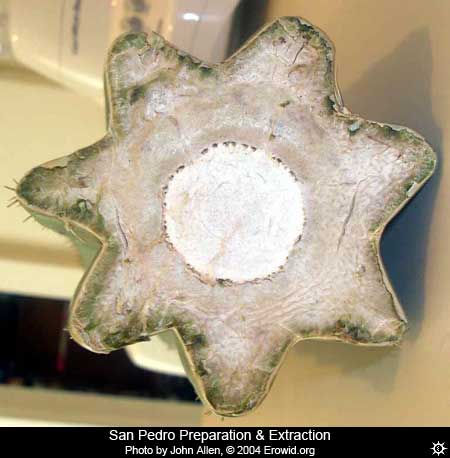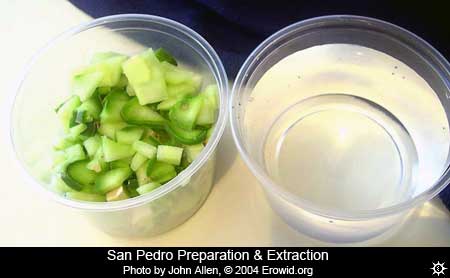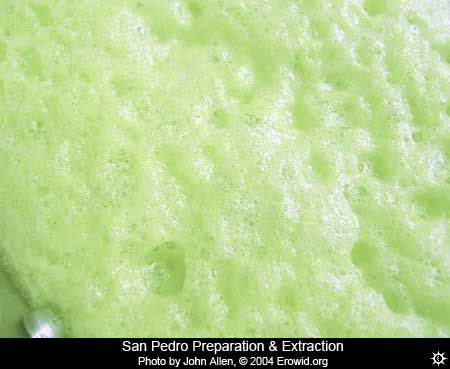San Pedro Preparation
The Preparation of San Pedro Cactus for Consumption
v1.1 - Feb 21, 2005
INTRODUCTION
Years ago in the early 1970s I became friends with the employees of a plant shop in the Seattle University District. What was really cool is that I found out that the owner of this plant shop was also the author, as well as the editor of several fine books such as "How to Grow the Finest Marijuana Indoors under Halides" and "How to Grow Pot Hydroponically". They also published "How to Identify and Grow Psilocybe Mushrooms," by Jule Stevens and Rich Gee.
One of the employees and I went to the Seattle Arboretum in 1975 and were playing Frisbee when I dropped the Frisbee to the ground at the Woodlawn Park section of the Seattle Arboretum. As I bent down to pick up the Frisbee I noticed some interesting mushrooms in the field in which we were playing. I then lifted one shroom out of the ground and realized it was Psilocybe semilanceata. That really blew my mind. I showed my friend this shroom and he mentioned to me that since I showed an interest in these special mushrooms, maybe I would be interested in trying a San Pedro Cactus, which he told me, contained mescaline.
At that time in the early to middle 1970s, I learned that this cactus was from Peru and Ecuador and was used ritualistically in ceremonies similar to those associated with the ritualistic use of Peyote. I soon read a few papers and learn that the natives of these countries prepared their cacti as a drink that they knew as Chimora.

In 1976, the cost of such a cactus in the United States was $3.00 for a one to two pound cutting (see San Pedro Figure 1) and that such size would be equal to or equivalent to the dosage of 4 to 6 buttons of fresh peyote (See Peyote, Figure 2). In chemical terms that amount of the 1-2 pounds of San Pedro cactus was the equivalent and/or equal to 300 to 500 milligrams of pharmaceutical mescaline sulfate. This 1-2 pound San Pedro cacti dose was the same as a dose of 4-6 fresh buttons of peyotl consumed by members of the Native American Church.
My friends at the plant shop told me I would have to slice and cook the cactus for about four hours or so and then drink the remaining liquid. So I purchased about ten of the cacti and planted all but one of them in my home. Several of them I kept at a now out-of-business used bookstore in the University district of Seattle.
Well I chopped up the cactus and placed it into a small 4 quart cooking pot and began to boil the chopped pieces. I let this goop boil for a few hours and then strained off the pulp from the cactus and waited for it to cool off to drink it. And I did. After two hours I felt only a little tingle and I could not sleep the whole night but I never got high from it.
At that time, High Time Magazine was just one and half years old, with about six issues published, and now they were going monthly. In the first year of 12 issues, there were many ads for 6" cuttings of San Pedro Cactus for ten dollars each per cutting. I imagined that hundreds of interested people had bought this cactus, cooked it, drank the liquid (not enough to affect anyone), and then when nothing psychoactive occurred, went on thinking that they had royally been ripped off for their ten dollars. What a shame.
I learned a few days later from my friends that I had not prepared the cactus in the right manner and was apparently in too much of a hurry in my method of preparation. I recalled that the Indians of Peru and Ecuador who use these cacti (13 different species contain mescaline) have to boil the preparation in a black cauldron (kettle) for at least 12 to 24 four hours. However, I of the Western World, know the secret of the blender. Something the Indian does not have access to in his jungle. The magical Electrical Blender.
So here is one of many proper methods for preparing and cooking this cactus. And yes, I have used this method since the late 1970s and found it to be the best method I employ.
The Photographs in this article and the preparation of this cactus were prepared on the Island of Koh Samui where there are no laws against the consumption of this magical drink known as Chimora. After I returned from SE Asia I wrote the text and now I will present here a step-by-step photo pictorial on the preparation process for cooking this beautiful wonderful exotic magical entheogenic gift from the gods.
PREPARATION
| Items used in the preparation of Chimora include a blender, an 8-quart cooking pot, a spoon or wooden spatula, two empty potato salad containers (equal size) and some clean cloth used for straining. |
 |
|
 |
|
 |
|
  |
|
 |
|
 |
|
 |
|
 |
|
 |
|
 |
|
 |
|
   |
|
 |
|
 |
|
 |
|
 |
|
 |
|
 |
|
 |
|
 |
CONCLUSION
A shot of cactus juice is much easier to swallow than chewing bitter-tasting fresh cactus or peyote buttons. Each swallow of the mixture can be accompanied by a drink of water or other beverage to counter the mildly bitter taste of the san pedro juice. Eliminating the chewing of the cactus material also helps attenuate feelings of nausea commonly associated with ingesting cactus. Swallowing this juice slowly over a half-hour or so (rather than rapidly drinking it down) can help acclimate the body to the material gently and avoid shocking the nervous system.
Copyright 2005 John W. Allen and Erowid


